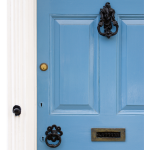
Yep. It’s probably a wooden door. But use your imagination…
In an earlier article, we talked about painting your old steel doors. And while all that information was absolutely flawless (!) in it’s delivery, it’s probably important that we take a second here and attach an addendum.
See, we often talk to people in the store at RepcoLite about their new doors and we usually discover there’s a misconception as to what needs to be done. Most people tend to think that since their steel or fiberglass door is NEW, they need to do no prep work. It’s one of the perks of buying a new door, right?
Unfortunately . . . wrong. New doors, even if they’re pre-primed, need to be prepped correctly. Even if they’re new, they can be covered with surface contaminants that can affect the adherance of your finish coat. So, even though your door may be new, it still will need to be prepped correctly before you move on to the paint.
Here are the steps:
- SCUFF SAND: Do a light scuff sanding of the door with some 120 – 150 grit paper. Even though the door is pre-primed, it never hurts to dust over it lightly with some sandpaper to level out any bumps in the primer coat.
- WASH THE DOOR: After you’ve sanded the door, be sure to wash over it with TSP (TriSodium Phosphate). This will remove the dust you created while sanding AND it will remove any contaminants that could be on the surface (body oils from installation, airborne dirt and grime, etc.)
Doing those simple prep steps will help ensure that the paint job on your new door will look great for years to come!

